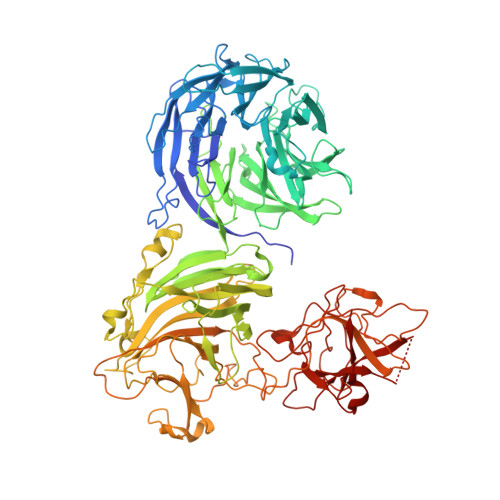Crystal Structure of Bifunctional Aldos-2-Ulose Dehydratase/Isomerase from Phanerochaete Chrysosporium with the Reaction Intermediate Ascopyrone M.
Claesson, M., Lindqvist, Y., Madrid, S., Sandalova, T., Fiskesund, R., Yu, S., Schneider, G.(2012) J Mol Biology 417: 279
- PubMed: 22330145
- DOI: https://doi.org/10.1016/j.jmb.2012.02.001
- Primary Citation of Related Structures:
4A7K, 4A7Y, 4A7Z - PubMed Abstract:
The enzyme aldos-2-ulose dehydratase/isomerase (AUDH) participates in carbohydrate secondary metabolism, catalyzing the conversion of glucosone and 1,5-d-anhydrofructose to the secondary metabolites cortalcerone and microthecin, respectively. AUDH is a homo-dimeric enzyme with subunits of 900 amino acids. The subunit consists of a seven-bladed β-propeller domain, two cupin folds and a C-terminal lectin domain. AUDH contains a structural Zn(2+) and Mg(2+) located in loop regions and two zinc ions at the bottom of two putative active-site clefts in the propeller and the cupin domain, respectively. Catalysis is dependent on these two zinc ions, as their specific removal led to loss of enzymatic activity. The structure of the Zn(2)(+)-depleted enzyme is very similar to that of native AUDH, and structural changes upon metal removal as the cause for the catalytic deficiencies can be excluded. The complex with the reaction intermediate ascopyrone M shows binding of this compound at two different sites, with direct coordination to Zn(2+) in the propeller domain and as second sphere ligand of the metal ion in the cupin domain. These observations suggest that the two reactions of AUDH might be catalyzed in two different active sites, about 60 Å apart. The dehydration reaction most likely follows an elimination mechanism, where Zn(2+) acts as a Lewis acid polarizing the C2 keto group of 1,5-d-anhydrofructose. Abstraction of the proton at the C3 carbon atom and protonation of the leaving group, the C4 hydroxyl moiety, could potentially be catalyzed by the side chain of the suitably positioned residue His155.
- Department of Medical Biochemistry and Biophysics, Karolinska Institutet, S-171 77 Stockholm, Sweden.
Organizational Affiliation:



















